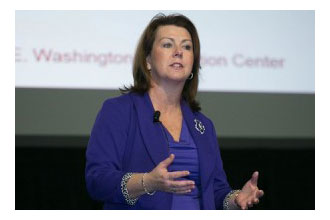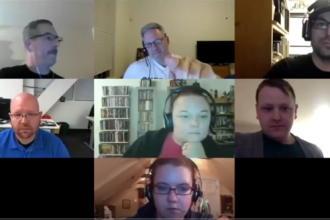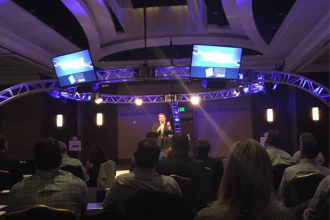InfoComm: Overheard at GovComm 2013
By Brad Grimes
InfoComm International
 Seriously, next time GovComm, the D.C.-area AV/IT trade show put on by InfoComm, rolls around, drop by, if for no other reason than to take in the federal technology lingo. People like Day One keynote speaker Jill Tummler Singer (pictured) really know their AV and IT, and they talk about it in ways you and I do not. They’d be the first to tell you that just because they know their technology doesn’t mean the government is on the cutting edge. Understanding this is key to working on government projects (actually, one of many keys).
Seriously, next time GovComm, the D.C.-area AV/IT trade show put on by InfoComm, rolls around, drop by, if for no other reason than to take in the federal technology lingo. People like Day One keynote speaker Jill Tummler Singer (pictured) really know their AV and IT, and they talk about it in ways you and I do not. They’d be the first to tell you that just because they know their technology doesn’t mean the government is on the cutting edge. Understanding this is key to working on government projects (actually, one of many keys).
At one point during her speech, Singer, a former CIO for the National Reconnaissance Office and a former deputy CIO for the CIA, said, “The interface in a Tesla is better than any interface we have in mission today.” Translation: Goverment workers are a little behind the times in the way they interact with important systems. Has anyone reading this designed any great user interfaces lately? 1,658 of you? I thought so. Little help, please.
Of course, just because government needs good technology solutions doesn’t mean the government market it easy to crack. Singer said as much when she advised GovComm attendees to partner with traditional government integrators. “Because government trusts them,” she said.
And as I blogged about after GovComm 2012, brush up on the lingo, acronyms, program names, etc. that government tech folks live and breathe. Without further ado, my GovComm 2013 user’s guide:
Unclassified disclosure event. Think “Snowden.” Singer was actually trying not to say the word, “Snowden.” It was an oddly humorous moment related to a serious-as-a-heart-attack issue for Singer and other government technology workers. Systems need to be secure–to a level only the government can come up with. Singer said the government is all for wireless solutions, for example, provided they’re approved for classified communications. She said there are many new federal buildings constructed in the last five years with great wireless infrastructures–but the wireless hasn’t been turned on yet.
Consolidated infrastructures. You guys know all about this. What I didn’t know is that in classified government buildings, there are typically 16 physical networks. Try consolidating that.
Unified comms. Yep, to government, communications are just comms. But, reflecting a line of thinking already embraced in pro AV, Singer added, “What we really mean is unified collaboration.” CIOs like Singer want what everyone else wants–the ability to launch ad hoc (secure) online meetings regardless of hardware or software platform. She wants to be able to call into a room-based videoconference from a smartphone in the airport. Sound familiar? Seems like a perfect “in” for AV integrators. Of course, she may need you to record and store that conversation for 25-plus years, depending on statutes. May need to understand Big Data and The Cloud for that.
OCONUS. Outside the Continental United States. Apparently, a lot of collaborating happens there. I’m just always impressed when something like “OCONUS” rolls of a government technology professional’s tongue the way “milk” rolls off mine.
FDCCI. This is a biggie. Gotta know this one. It’s the Federal Data Center Consolidation Initiative. In 2010, the federal government decided enough was enough. Too many wasteful, duplicative data centers. As Singer put it, related to new AV systems, “You can’t bring in five new racks.” That’s very anti-FDCCI. Plan ahead.
FirstNet. This is a huge government technology program that spans federal, state, and local agencies. It’s estimated to cost $7 billion (more, would be a safe bet). And it’s been in the works since 9/11. Remember how immediately after those tragic events, it was clear that first responders had a hard time communicating? FirstNet is envisioned as an all-new, interoperable first responder network.
CAPEX vs. OPEX. This isn’t government-centric, but government especially isn’t rushing out to incur many technology-related capital expenses these days. Wired solutions are being upgraded slooooowly. So think of AV solutions as operational expenses. “If you can sell it as a service and we can find an acquisition officer who can buy it as a service, it could be a win-win,” Singer said. Read any good AV articles about services lately?
Dronestagram. Just take a peek. Fun. “Drone” doesn’t have to be a bad word.
And it wouldn’t be a Grimes blog post if I didn’t bury a lead. My favorite turn of phrase from Singer was when she asserted that government technology pros want their Mondays to be like their Sundays. In other words, they want their mission technology solutions to be as intuitive and user-friendly as their home technology. She’s a big BYOD proponent. She wants (and this is key for AV integrators) “contemporary situational awareness.” Today’s operations centers are little more than lots of displays stacked together, she says, which looks impressive, but doesn’t present a better view of whatever important information its users must visualize. She wants her solutions on-demand (read: cloud), and she envisions a day when government culture gets over the in-person meeting and embraces “virtual presence.”
GAO. That’s the Government Accountability Office. Singer thinks they should study how much government time is wasted driving around the Beltway to meetings. UCC is the wave of the future.
And it’s a language government and pro AV share.
This column has been reprinted with permission from InfoComm and originally appeared here.





